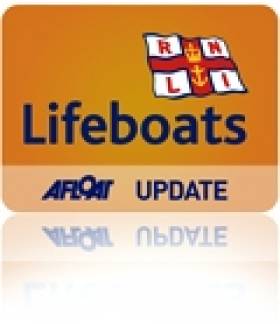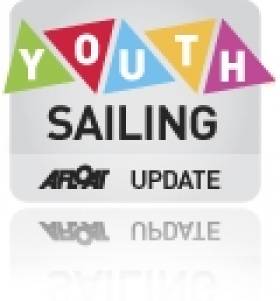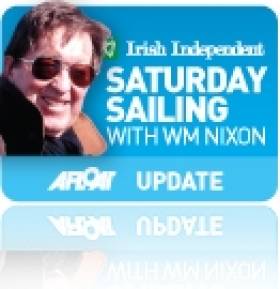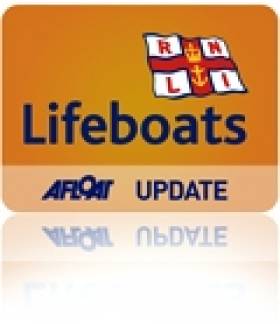Displaying items by tag: Howth
#Jailed - A Dublin man has been sentenced to three years in prison following his conviction for assault on a tourist during the Tall Ships Festival in August 2012.
As Newstalk reports, Thomas Reilly of Dublin's North Strand was convicted by a jury in January after the court heard he had lured British visitor Colin Ryder to the water's edge at Howth's West Pier before pushing him into the water.
Ryder sank under a boat moored at the pier-side but was rescued after nearby youths threw him a rope to drag him to safety.
The sentencing comes in what was a second trial over the incident for Reilly, who has 68 previous convictions, after a jury failed to agree a verdict in May last year.
Newstalk has much more on the story HERE.
Riot Squad On Alert After Mass Brawl In Howth
#Antisocial - The Garda riot squad was put on alert at popular coastal spots in Dublin yesterday to avoid a repeat of the mass brawl in Howth on Saturday 31 May.
As The Irish Times reports, the Public Order Unit was sent in to Howth Harbour to disperse the crowd, said to comprise several hundred teenagers - many of whom were described as drunk and disorderly.
The Sunday Independent says up to 100 youths were involved in a fight that broke out among the gathering between two separate groups, though no arrests were made.
The same newspaper also spoke to a teenage girl who was caught up in the fracas with her friends.
Eva Drum from Ballymun says she was "punched, kicked, bitten and scraped" in the melee after rowdy teens suddenly attacked her group - and turned on her when she shouted at them to stop.
Dart services were suspended at Sutton station for a time on Saturday afternoon to prevent the crowds increasing.
#rnli – A member of Howth RNLI was honoured at the RNLI Annual Presentation of Awards at the Barbican Centre in London last Thursday (22 May 2014).
Rupert Jeffares, the Lifeboat Operations Manager with Howth RNLI, was awarded a Bar to the Gold Badge. This is the second highest award that is made by the charity. Rupert has dedicated 50 years to serving the RNLI and saving lives at sea. He joined the lifeboat crew in Howth in the mid-sixties and later took on the role of Lifeboat Operations Manager. In this volunteer role Rupert is in charge of authorising the launch of the lifeboat and the day-to-day station management.
Owen Medland, RNLI Divisional Operations Manager paid tribute to him, "Rupert Jeffares demonstrates the selflessness of the RNLI's volunteers ashore in support of our crews. He has given many years of continuous service in his role as Lifeboat Operations Manager, often forsaking family and work in support of Howth Lifeboat. It is such individuals that make the service world class and it is fantastic to see him acknowledged for his dedicated service."
"On behalf of everyone at Howth RNLI, I want to congratulate Rupert on his outstanding achievement. His award is richly deserved after years of tireless dedication to the lifeboat in Howth. This accolade demonstrates the high esteem in which Howth Lifeboat Station is held by the hierarchy of the RNLI", commented Russell Rafter, Chairman of Howth RNLI.
#youthsailing – Séafra Guilfoyle from Cork has beaten off stiff competition to win the Laser Radial division of the Irish Youth Sailing Championships at Howth Yacht Club today. A reported 250 sailors were competing across five classes since Thursday, with Saturday blown out and the regatta sailed in mainly in light to medium conditions.
Up for grabs at the annual youth event which was entirely single–hander based (except for a fleet of 13 double–handed 420s) were places on squads and teams for international events.
Overall results for each class (Laser radial, 4.7, Topper, 420 and Optimist) are downloadable below as jpeg files.
Only one point separated Séafra Guilfoyle and fellow Royal Cork Yacht Club member Cian Byrne after the first race today. Both sailors were again neck and neck for the second race which left them tied on points and all to play for in the ninth and final race of the championship.
When it came down to the last race this afternoon Guilfoyle and Byrne were tied on points so the pressure was really on for both of them to perform. The final turned in to a match race between the pair who both finished mid-fleet. But discarding those points, it was Séafra who came out on top with 24 points. Cian finished on 25 points to take the silver while another Corkonian; Ross O'Sullivan from Kinsale scooped the bronze. Sarah Eames from Ballyholme Yacht Club finished seventh overall and takes the prize for first girl.
Guilfoyle, a past Irish Optimist champion, took to Twitter to pass on the news of his latest success:
Youth national champion! Qualified for the youth worlds in July absolutely delighted!
— Séafra Guilfoyle (@SeafraGuilfoyle) April 27, 2014
In the 420 double-handed class local Howth sailors Robert Dickson & Sean Waddilove won the regatta with a race to spare. The 2013 champions are currently in transition year and have spent their academic year studying in France where they have also been able to put in a lot of training and competition time on the water. And their hard work certainly paid off. They put in a solid performance over the three days which shows in their results of 1, 1, 2, 2, 4, 2, 2, 2, 2. Finishing in second place overall were Peter McCann & Arran Walsh from Royal Cork and in third as well as first girls were the McDowell cousins Lizzie and Cara from Malahide.
In the Laser 4.7 class overnight leader Nicole Hemeryck took the first race win of the day to extend her lead by seven points. Johnny Durcan from Cork was 2nd which moved him up to 2nd overall. His win in race five, along with the discard coming in to play, then narrowed the gap to five points. But even a win in the final race for Johnny wasn't enough to catch Nicole who is the new 2014 ISA Laser 4.7 Champion. An impressive feat for the Dun Laoghaire girl who only recently graduated from the junior Topper class to the Laser. Settling for silver was Johnny Durcan followed by Conor Sherriff in third.
In the Topper class Hugh Perrette knocked Geoff Power off the top spot after the first race of the day and held on to that position for the rest of the championship. Of the six races, the National Yacht Club sailor won four which along with a 3rd and discarded 8th was enough for him to claim the gold. Geoff Power from Waterford was 2nd overall while Heather Spain from the National Yacht Club earned both third place overall and first girl.
Strengthen Fingal's Freedom for the Good of Irish Sailing
#fingal – The Government's recent move to create a framework for the direct election of a new all-powerful Mayor for Dublin was expected to be a shoo-in. The new Super-Mayor's authority would incorporate the current four local councils of Dun Laoghaire-Rathdown, South Dublin, Dublin City, and Fingal, each one of which had to vote in favour. But Fingal's councillors voted firmly against it, despite emphatic support of the proposal by the councillors in the other three areas. As a Fingallion by adoption, W M Nixon strongly supports this independent move by a largely rural and coastal region which has a longer shoreline than all the other Dublin areas put together, and is clearly not a naturally integral part of the city.
Fingal is the Ukraine of Leinster, and the glowering monster of Dublin is the Russia within Ireland, intent on the conquest of its smaller freedom-seeking neighbour. Vigorous, all-powerful, intensely urban, and distinctly impressed with itself, Dublin is certain that the further its bounds are spread, the better it will be for all its citizens. And the more citizens it can claim, then the better for Dublin.
But Fingal is different. For sure, it can seem a bit sleepy and rural by comparison with central Dublin, but that's the way we like it. It's a place of odd little ports and much fishing, a region of offshore islands, rocky coasts and many beaches on one side, and the profound heart of the fertile country on the other. A place where – as you move north within it - you might make a living in many ways at once, taking in growing vegetables, raising animals, running a dairy herd, and keeping a lobster boat down at the local quay, while perhaps having a horse or two as well. And if you feel like more shore sport, the golfing options are truly world class.
As for the sailing and all other forms of recreational boating, Fingal is not just a place of remarkable variety – it's a universe. With five islands – six if you count Rockabill – its 88 kilometre coastline is one for sport, relaxation and exploration. Sea angling is well up the agenda, and it's a kayakers' paradise, while Irish speed records in sailboarding and kite-surfing have been established in the natural sand-girt canal which forms for much of the tidal cycle in the outer Baldoyle estuary immediately west of Howth.
Apart from fishing boats – and inshore they're usually only the smaller ones – it has no commercial traffic. And though there are tidal streams, in southern Fingal's main racing area between Ireland's Eye and Lambay, they're not excessively strong, and run in a reasonably clear-defined way, while the flukey winds which so often bedevil Dublin Bay away to the south are much less of a problem in sailing off Fingal, where the winds blow free.
The range of boat and sailing clubs of Fingal matches the variety of its coast. The most southerly is Sutton Dinghy Club, rare among Ireland's yacht clubs in being south-facing. It may be focused on sailing in Dublin Bay, but scratch any SDC sailor, and you'll find a Fingallion. Round the corner of the Baily – not a headland to be trifled with - Howth has two clubs, the yacht club with its own marina, and Cumann na Bhad Binn Eadair (the Howth Sailing & Boat Club) in the northeast corner of the harbour, while Howth Sea Angling Club with its large premises on the West Pier is one of the tops in the country.

The sunny south. Sutton Dinghy Club is Fingal's most southerly sailing club, and is also rare in Ireland through being south facing.
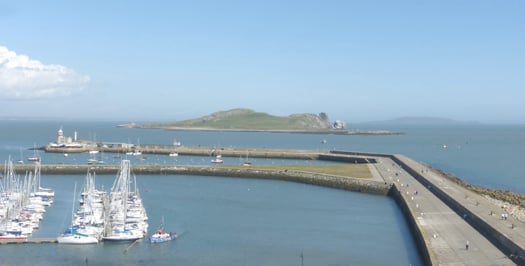
Islands of Fingal seen across the eastern part of Howth marina, with Ireland's Eye in the foreground, and Lambay beyond. Photo: W M Nixon
As for the waters they share, their most immediate neighbour is the steep island of Ireland's Eye with its pleasant southwest-facing beach, the island itself a remarkable wild nesting site, particularly when you remember that it's close beside an intensely urban setting. When a discerning visitor described Ireland's Eye as "an astonishing and perfect miniature St Kilda", he wasn't exaggerating.
Across in Malahide, where we find Fingal's other marina, Malahide YC - which recently celebrated its Golden Jubilee and currently has Graham Smith as its first second-generation Commodore – is in the curious position of having two clubhouses. One is a charming and hospitable place among trees within easy stroll of the marina, while the other is west of the long railway embankment which retains the extensive inner waters of Broadmeadow. This makes the waters into a marvellous recreational amenity and boating and sailing nursery, so not surprisingly it is home to active sailing schools. And it is also the base of Malahide YC "west", a dinghy sailing club on the Broadmeadow shore at Yellow Walls, while further west of it again is yet another club, the more recently formed Swords Sailing & Boating Club.

The map of modern Fingal shows how the southwest corner of the present region seems remote from the largely coastal and rural nature of much of the rest of the county. And it also confirms the surprise (to many) that the Phoenix Park is in Fingal.
North from Malahide, and you're into "Fingal profonde", its deeply rural nature occasionally emphasised by the sea nearby. The long Rogerstown Estuary, the next inlet after Malahide, sometimes found itself providing the northern boundary of The Pale, and as recently as the early 1800s the river at Rogerstown and the tiny port of Rush were a veritable nest of smugglers, privateers and occasionally pirates, with buccaneering captains of myth and legend such as Luke Ryan and James Mathews proving to have been real people who were pillars of society when back home in their secretive little communities after their lengthy business forays to God know where.

Muddy situation. Low water in the Rogerstown Estuary. The hill in the distance on the left is new – for years, it was the largest dump in Ireland, the Balleally Landfill. But now it is well on its way to rehabilitation as an enhancement of the landscape. Photo: W M Nixon
The Rogerstown Estuary went through an unpleasant period when its inner waters were dominated by the nearby presence of the biggest waste dump in Dublin, Balleally Landfill. It rose and rose, but now it's closed, and is in process of being revived to some sort of natural state. The result is that the vista westward from Rogerstown is much improved by a pleasant and completely new hill which so enhances the view at sunset that shrewd locals have built themselves a row of fine new houses facing west, along the quirkily named Spout Lane which runs inland from the estuary.
Whatever about the legality-pushing privateer skippers who used Rogerstown Estuary as their base in days of yore, these days it's home to the quay and storehouse which serves the ferry to Lambay, which is Fingal's only inhabited island when there are no bird wardens resident on Rockabill, and it's also the setting for another south-facing club, Rush SC. It is spiritual home these days to the historic 17ft Mermaid Class (they still occasionally build new ones in an old mill nearby), but despite the very strong tidal streams where the estuary narrows as it meets the sea, RSC also has a large cruiser fleet whose moorings are so tide-rode that unless there's a boat on the buoy, it tends to disappear under water in the final urge of the flood. This can make things distinctly interesting for strangers arriving in and hoping to borrow a mooring while avoiding getting fouled in those moorings already submerged. Not surprisingly, with their boat sizes becoming larger like everywhere else, Rush SC find that their bigger cruisers use Malahide Marina.
To seaward of Rogerstown, with the little port of Rush just round the corner, the view is dominated by Lambay. A fine big island with is own little "miniature Dun Laoghaire" to provide a harbour on its west side, it has a notable Lutyens house set among the trees. But for many years now Lambay has been a major Nature Reserve, so landing is banned, though anchorage is available in its three or four bays provided you don't interfere with the wildlife along the shore. This makes it off bounds to kayakers who might hope for a leg stretch on land, though it's still well worth paddling round close inshore.
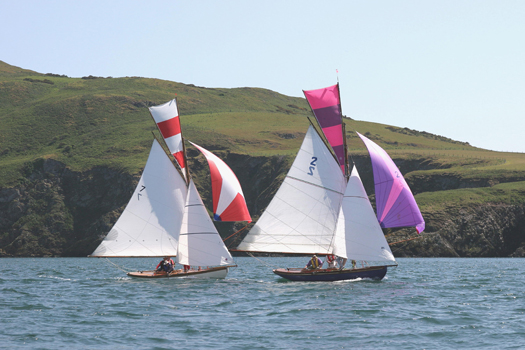
Racing round Lambay. Close competition between the Howth 17s Aura (left) and Pauline, which have been racing annually round Lambay since 1904. Photo: John Deane
Along the Fingal mainland coast, the next inlet after Rush is Loughshinny, a lovely natural harbour with a quay to further improve the bay's shelter. There's a very active little fishing fleet, while the shoreside architecture is, how shall we say, decidedly eclectic and individualistic? Go there and you'll see what I mean.
Six miles offshore, Rockabill marks the northeast limits of Fingal. It's a fine big double-rock, with a substantial lighthouse and characterful keepers' houses attached. But as it's now automated, the only time Rockabill is inhabited is for the four summer months when a bird warden or two take up residence to monitor the rocky island's most distinguished summer residents, Europe's largest breeding colony of roseate terns.
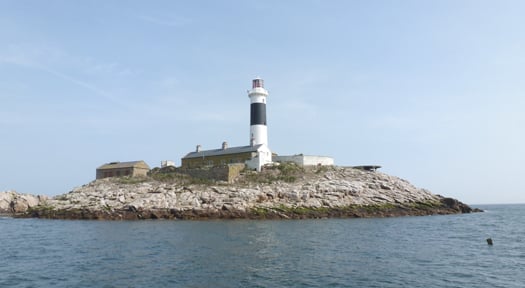
Rockabill, where the shy roseate terns feel at home. Photo: W M Nixon
In Fingal we tend to take these pretty but noisy summer visitors for granted, but the word is that south of Dublin Bay the tern buffs are so incensed by Rockabill having a clear run that they're tried to start a rival colony of roseate terns on the Muglins, and built a row of tern houses (one good tern deserves another) to facilitate their residence. The potential nest sites may not have survived the past severe winter. But in any case, one wonders if they had planning permission from Dun Laoghaire/Rathdown council for this development? Persons suggesting that such a development would almost certainly be terned down will not be given any attention whatsoever.
Skerries and Balbriggan are the two main sea towns of north Fingal, and they're as different as can be, the difference being emphasised by historic rivalry. It's said that back in the government harbour-building days of the late 19th Century a grant was made available to assist local landowners to make significant improvements to one of the harbours, and this meant war.

Balbriggan may very definitely dry out, but it provides a secure home port for both trawlers and other boats prepared to settle on the mud and sand. Photo: W M Nixon
So eventually the grant was split with half going to improve Balbriggan, and the other half to Skerries, with neither being a total success. If you seek total shelter in either today, you have to be prepared to dry out, while the anchorage off Skerries is also subject to a large tidal whorl which means that when the ebb is running in a strong onshore wind, the moorings are doubly rough and diabolically uncomfortable. And every so often after an exceptional nor'easter, we have another litany of boats driven ashore and Skerries yacht insurance going even further through the roof.
It's a situation which needs proper attention from an administration which is genuinely interested in the port. And the proper development of the harbour at Skerries, while retaining the little old place's special character, is surely something which could be much better done by Fingal Council rather than some remote Mayor of Dublin for whom Skerries will be the outermost periphery, a place seldom visited, if at all.
We've seen it all before. Time was when Fingal was simply the North County, little noticed in the centres of power which were basically Dublin City and Dublin County, their head offices in the heart of the city. But then in 2001 the new four-council setup was created, and the old name of Fingal – never forgotten by those who cherished the area – was revived. A very fine new user-friendly County Hall – it has even been praised by Frank McDonald of The Irish Times – was built in the re-born county town of Swords. Out on the new boundaries meanwhile, the signs went up saying "Welcome to Fingal County". But we old Fingallion fogeys pointed out that as Fingal means "Territory of the Fair Strangers" (i.e the Norsemen rather than the Danes), it was superfluous to be describing it as "the county of the territory", so these days it's just Fingal, and we're happy with that.
Here in Howth, we sort of slipped into acceptance of the new setup. Once upon a time, from 1917 to 1943, Howth had its own Urban District Council. It says much for the place's remoteness from the world that the HUDC was established in the midst of one global war, and quietly wound up in the midst of another. In 1943, Commissioners had to be imposed on the tiny fiefdom to offset the fact that some local interests thought the HUDC existed entirely for their own personal benefit. So at various times since, Howth was run either by Dublin County Council, or even by Dublin City Corporation. We were assured that this latter setup was all to our benefit, as the powers-that-be in City Hall had a soft spot for Howth, sure wasn't it the place where the mammy went every Thursday evening to buy the family's fish, and wouldn't she want to see it looking well?
Maybe so, but when it came to doing something more useful with the harbour, Howth Yacht Club – having re-constituted itself in 1968 from an amalgamation of Howth Sailing Club (founded 1895) and Howth Motor Yacht Club (founded 1934) - found itself dealing with a bewildering variety of government departments as the lowly interests of fishing and its ports seemed to be shifted whenever possible by civil servants who reckoned that banging the drum on behalf of fisheries in particular, and maritime interests in general, was not a shrewd career move for anyone planning a steady progress up the very landbound Irish public service ladder to the sunlit uplands of a long and prosperous retirement.
So if at times absolutely nothing seemed to be happening in a harbour which was painfully inadequate for expanding boating and fishing needs, it was partly because the club officers and fishermen's leaders could find it difficult to discern just who in authority could or would make the decisive call. In those days it turned out to be somewhere in the hidden recesses of the Office of Public Works. Suddenly, in 1979, a plan for the major re-development of the harbour was promulgated at official level, with a radical rationalisation planned for its future use. The western part, it was proposed, would become totally fisheries, while the eastern part was to be given over to recreational boating, all of it involving major civil engineering and harbour works projects.
Looking at the successful harbour today, it all seems perfectly reasonable and sensible. But back in 1979 when HYC were presented with a time-limited take-it-or-leave-it choice, the way ahead was not at all clear. Friendships were sundered and family feuds emerged from the heated progress towards accepting the offer that the club agree to vacate its premises on the West Pier - a clubhouse which it had renovated and extended only ten years earlier – and commit itself to the installation, at members' cost, of a marina in the eastern harbour with the obligation to build a completely new clubhouse there.

Today's Howth Harbour didn't happen overnight. This is how it was from 1982 until the new clubhouse was completed in 1987. Photo: W M Nixon
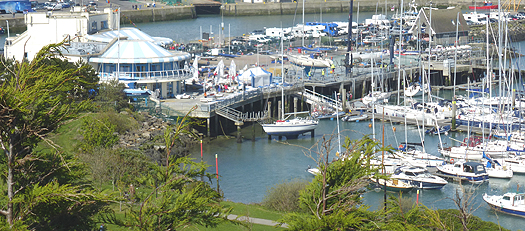
Multiple activities under way at Howth YC this week. The club's setup may seem only natural now, but it was quite a struggle to get there. Photo: W M Nixon
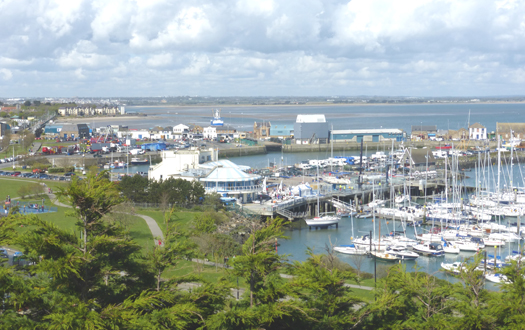
Howth's vibrant mix of a working fishing port and busy sailing centre has provided the ideal setting for the development of a successful visitor and seafood destination. Photo: W M Nixon
It's all history now, but it was done. And done so well by those involved that today it's simply taken for granted. Arguably, it's a compliment to those who created the Howth YC setup, that newer members should seldom wonder how it all came to happen, it just seems so right and natural. And as for those running the club, they in turn have to build on past achievements in dealing with an ever-changing administrative environment in which the changeover to being part of Fingal was only one of several evolutions.
Yet the recent attempt to abolish Fingal was a wake-up call. In Howth we may have wandered into it, but in just a dozen years, a dormant Fingal identity has come quietly but strongly awake. In Howth village it's natural enough, as our backs are turned to Dublin and we look to the rest of Fingal. But even on the south side of the hill, where fine houses face across Dublin Bay and you'd expect a sense of identity with households in similarly choice locations for all that they look north out of Dun Laoghaire, you find that the attraction of visiting the southside has the exotic appeal of going foreign, while those of us more humbly placed in the village, if visiting remote places like Rathmines or Terenure, find it positively unnerving to think of all the houses between us and the sea.
Then too, while Fingal Council has been establishing itself in our hearts and minds, it has been a good time for Howth Harbour. Good fences have been making good neighbours, and though marine administration in government has been kicked from pillar to post, an underlying Department of Fisheries recognition that their harbours cannot be only about fishing has led to a re-think on the use of buildings about the harbour, with Howth becoming an extraordinary nexus of good seafood restaurants, such that on a summer evening, despite the presence of a traditional fish and chip shop, the seafood aroma is of a proper fishing port in Brittany or Galicia. In fact, rents from the hospitality and sailing and marine industries in Howth have now reached such a level that fish landing fees – formerly the bedrock of the harbour economy – only contribute about 10% of the overall income.

The man from County Hall. Fingal Mayor Kieran Dennison is comfortable with his county's busy sailing activities, and the sailors are comfortable with him. He is seen here officially opening the J/24 Worlds at Howth in August 2013. Photo: W M Nixon
As for how we've been getting on with our new masters in County Hall up in Swords, the news is good. Most recently, we've been having direct contact with the current Mayor of Fingal, Kieran Dennison, who hit just the right note when he officially opened the J/24 Worlds in Howth in August 2013. Following that, he was back at the annual Commodore's Lunch in HYC in the dark days of November when a review of the past season lightens the onset of winter, and he was able to tell us that thanks to contacts made at the Worlds, his invitation to visit the America's Cup in San Francisco in September was made even more enjoyable. Those of us who reckoned the only way to visit the 34th America's Cup was on the television screen were reassured by the thought that if somebody was going to represent us in the San Francisco bear-pit, then our Mayor, our very own Mayor of Fingal, was just the man for the job.
So we very much want to keep Fingal in existence and in robust good health, but we appreciate that its current boundaries might be creating a bit of a Ukraine-versus-Russia situation. In particular, the southwest of the county could well be Fingal's Crimea and Donetsk regions. There, relatively new settlements of ethnic Dubs in places like Clonsilla, Castleknock, Blanchardstown could become such a source of trouble that it might be better to transfer them peacefully to administration by either Dublin city or South Dublin before there is unnecessary bloodshed.
The situation arises because, when the boundaries were being drawn, southwest Fingal was set out all the way down to the Liffey. The Fingallion instinct would be to see the border drawn along the Tolka, in other words the M3. But there could be trouble because of the discovery – always something of a surprise – that the Phoenix Park is in Fingal. I could see that when some people find our Fingal includes the Park, they'll want to fight for it, particularly as, in the southeast of the county, the excellent St Anne's Park in Raheny was somehow allowed to slip into Dublin City.
One thing which is definitely not for transfer is the Airport. It is naturally, utterly and totally part of Fingal. For sure, it contributes a fifth of the county's annual income from business rates, making Fingal the economically healthiest Irish county. But we in Fingal have to live with the airport very much in our midst. If Dublin really wants to take over the airport, then a first condition before negotiations even begin would be that all flight paths are to be re-routed directly over Dun Laoghaire and Dalkey. A few weeks of that would soon soften their cough.
Whatever, the recent kerfuffle about Fingal rejecting involvement in administration by an all-powerful Mayor of Dublin has been a powerful stimulant to thinking about how our own county might best be run. Everyone will have their own pet local projects, and most of us will reckon that decision-making in Swords, rather than in some vast and impenetrable office in the middle of Dublin, will be the best way to bring it about. For those of us who go afloat, the fact that Fingal Council shows that it cherishes its long and varied sea coast, rather than preferring to ignore it, is very encouraging. And the fact that this prospering county has some financial muscle all of its own gives us hope that we can build on what the past has taught us, and spread improved facilities to every port. Should that happen, it will in turn benefit Irish sailing and boating generally to a greater extent than would restricted development under one closely-controlled central administration headed by some southside megalomaniac.
Two Tourists Injured At Howth Cliffs
#Rescue - Two tourists have been rescued after falling from cliffs at Howth Head yesterday afternoon (Saturday 5 April).
Howth Coast Guard Cliff Rescue volunteers immediately reported to the scene at Lion's Head after 5pm, where they found a teenage boy calling from help from the cliff face some 20 feet from the top.
Working quickly as the teen was at risk of slipping further down the cliff, rescuers lowered a rope to secure him before a winchman from Irish Coast Guard helicopter Rescue 116 was able to reach the casualty, who had minor injuries, and lift him aboard.
Meanwhile, the second casualty, an older male, was found to have fallen 150 feet to the beach at the foot of the cliffs.
He was stabilised by paramedics while Rescue 116 prepared to airlift him to Tallaght Hospital for treatment. His condition is not yet known.
Howth Coast Guard Assists Medevac From Fishing Vessel
#Coastguard - Howth Coast Guard was among many emergency units responding yesterday afternoon (Sunday 26 January) to an incident on a fishing vessel in Dublin Bay where a crew member had fallen in a storage area and lost consciousness.
Coastguard helicopter Rescue 116 was dispatched to get a winchman paramedic on board the vessel amid difficult weather conditions to stabilise the patient.
Due to the sea state and the location of the casualty, it was considered the safest option for the trawler to head to port with the coastguard paramedic remaining on board.
The Irish Coast Guard rescue team from Howth, a Dublin Fire Brigade unit from Kilbarrack and a HSE ambulance from Swords were tasked to attend the West Pier in Howth.
The patient had regained consciousness by the time he was successfully extracted by stretcher through narrow hatches to the deck and onto the pier, from where he was transported by ambulance to Beaumont Hospital for further evauluation.
Dublin Rescue Helicopter In Christmas Eve Medevac
#Coastguard - The Howth unit of the Irish Coast Guard reports that it was tasked to assist the Dublin-based rescue helicopter with a medical evacuation landing on Christmas Eve.
Rescue 116 landed at the OBI fire brigade training college on Malahide Road where the casualty was transferred to a waiting ambulance.
The medieval marked the first such operation for Rescue 116 and the expansion of the medevac programme trialled by the Shannon-based helicopter earlier this year.
Howth Coast Guard To Host Philippines Clothing Donation Drive
#Philippines - Howth Coast Guard will be hosting a donation drive for clothing and other items needed by people in the Ajuy area of the Philippines currently recovering from the recent Typhoon Haiyan disaster.
The coastguard station on the West Pier in Howth will be open this Saturday 23 November from 12pm to 2pm to take in light clothes such as shorts and T-shirts that are suitable for the warm climate in the Philippines.
Light bed linen and towels will also be accepted, and donors are asked to roll their items as tightly as they can into a bag so that the courier boxes can be filled as much as possible.
Howth RNLI Award Crew Members & Fundraisers at Annual Ceremony
#rnli – Volunteer lifeboat crewmembers and fundraisers were awarded certificates at the Howth RNLI's Supporter's Meeting last Wednesday in Howth Yacht Club (6 Nov).
Fundraisers who took part or organised wide range of activities from barbeques to kayaking, cycle rides to the Rose of Tralee were awarded Certificates of Thanks for their efforts. Ronan Murphy and the StaminUp group from Toned Fit took part in the To Hell & Back Challenge. Jennifer Murphy and Brendan Mulligan cycled from London to Paris. Gavin Pritcher organised the Dublin City Kayaking Challenge. Dermot and Liz Skehan held barbeques for Howth Yacht Club's White Sail Series and Kate O'Farrell entered the Rose of Tralee and choose the RNLI as her charity.
Ian Massey, lifeboat crewmember, received a Certificate of Service in recognition of over 20 years service to the RNLI. Lifeboat crewmembers Paddy Brown, Fred Connolly, Michael Duffy, Dave Howard, Rob Kerley, Ian Martin, Tim McDonnell, Stephen Mullaney, Ronan Murphy, Michael Murtagh, Manus O'Donnell, Adam Scott, Ian Sheridan and Joss Walsh received Casualty Care Certificates.
Howth RNLI's current fundraising campaign is aiming to raise money to fund a new pager system for the volunteer crew.




























